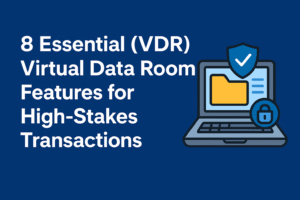In fast-moving markets like M&A, private equity, and enterprise fundraising, generic file-sharing platforms fall short. With M&A deal values rising 15% in the first half of 2025 and over half of U.S. companies actively pursuing deals, according to PwC, secure and efficient collaboration tools are no longer optional—they’re a requirement.
For organizations managing sensitive, high-value transactions, virtual data rooms (VDRs) must offer more than basic file storage. They need robust security, intuitive workflows, and features that cater to the demands of sophisticated stakeholders. Here are eight capabilities that define a VDR built for high-profile deals.
1. Bank-Grade Security and Fine-Grained Access Control
Security is paramount when managing multi-million or billion-dollar transactions. A high-quality VDR should implement enterprise-level encryption, such as 256-bit encryption for data at rest and SSL/TLS for data in transit—the same standards used in the financial industry.
Beyond encryption, access control is where top-tier VDRs differentiate themselves. Critical features include:
- User- and file-level permission settings (e.g., view-only, download, edit)
- Digital rights management (DRM) to prevent unauthorized sharing
- Ability to revoke access even after files are downloaded
- Watermarking with user identifiers
- Full audit trails that track every action taken within the data room
These tools ensure that sensitive documents stay protected and access remains accountable.
2. Streamlined Document Management
Slow document workflows kill momentum. An effective VDR simplifies file management so deal teams can stay focused on execution, not administration.
Also Read: Picks from Dolagim Jelpak: A Complete Guide
Key capabilities to look for include:
- Drag-and-drop upload for large batches of documents
- Support for all major file types to avoid compatibility issues
- Full-text search and filtering tools to locate files quickly
- Organized folder structures that mirror real-world workflows
These features help eliminate delays and miscommunication during due diligence or investor review.
3. Built-In Q&A and Collaboration Tools

In complex deals, questions come fast and frequently. A VDR that includes a Q&A module lets parties communicate directly within the platform, streamlining collaboration and reducing reliance on endless email threads.
Useful Q&A functionality includes:
- Assignable questions to team members
- Visibility controls to manage what each user sees
- Ability to elevate recurring questions into a searchable FAQ section
- Admin-level control to turn the feature on or off as needed
This centralization makes tracking diligence questions easier and ensures transparency across all parties involved.
4. Real-Time Activity Tracking
Knowing who’s reviewing which documents and when offers valuable insights into stakeholder engagement. Activity analytics give teams an edge by identifying where interest is highest and helping prioritize follow-ups.
Effective tracking tools show:
- Which files were viewed
- Who accessed them
- Time spent on each document
This visibility is especially helpful for identifying serious investors or partners and recognizing red flags before they become problems.
5. Simple, Browser-Based Access
VDR platforms should be accessible without technical hurdles. Whether it’s a PE partner logging in from a tablet or an attorney working remotely, the platform must perform consistently without plugins or installs.
Key usability features include:
- 100% browser-based access
- No Java or software installations required
- Interface designed for speed and simplicity
This ensures all parties can engage with the platform regardless of their location or technical skill level.
6. VIP Concierge Support
In high-stakes deals, time is often tight, and issues can’t wait. Concierge-level support ensures teams get the assistance they need when they need it.
What sets concierge support apart:
- Personalized onboarding and training
- Help with data migration and workspace configuration
- Fast, knowledgeable support via phone or email
- Availability beyond typical business hours
This kind of responsive service prevents minor roadblocks from becoming deal-breaking delays.
7. Multi-Workspace Management
For firms managing multiple transactions, investors, or portfolio companies at once, having dedicated workspaces is essential.
Robust multi-workspace capabilities offer:
- Segmented data rooms for each project or entity
- Centralized admin control with role-based permissions
- Unified dashboards to monitor all activity across workspaces
This structure is especially valuable for fund managers handling due diligence and LP reporting simultaneously.
8. API Integrations and Customization Options
When scalability and automation are priorities, integration becomes a major advantage. A VDR with open API support allows teams to tailor workflows and connect the platform with other business tools.
Examples of what an API-ready VDR can enable:
- Syncing documents with CRMs or reporting systems
- Automating recurring tasks and permissions
- Secure backups across private cloud infrastructure
- Branding customization for a consistent stakeholder experience
This level of customization ensures the VDR adapts to your firm’s existing systems and branding—not the other way around.
The Right Tools for High-Stakes Dealmakers
Not all virtual data rooms are designed with complex, fast-moving transactions in mind. The best platforms combine security, usability, and high-performance features to meet the needs of investment firms, legal teams, and advisors working on time-sensitive, high-value deals.
When evaluating a VDR solution, prioritize functionality that helps you move faster, collaborate smarter, and maintain full control over sensitive data. In high-stakes transactions, the right tool isn’t just a nice-to-have—it’s a competitive advantage.

